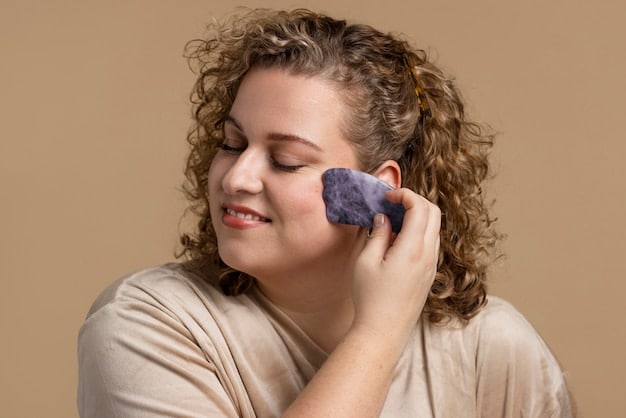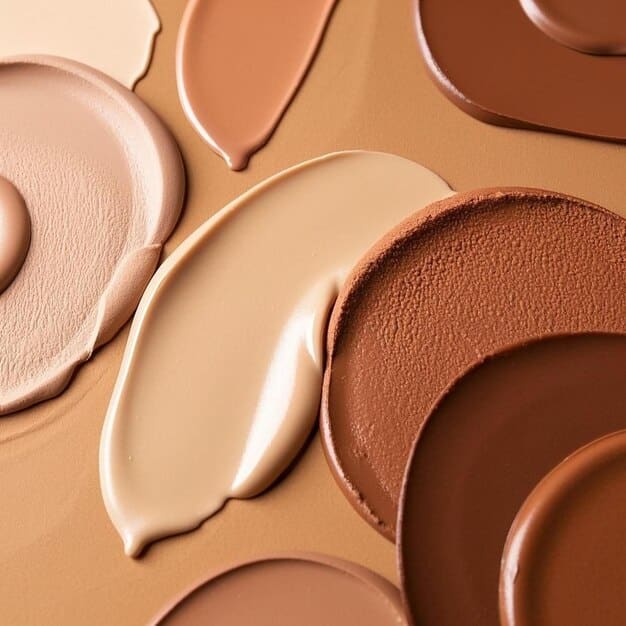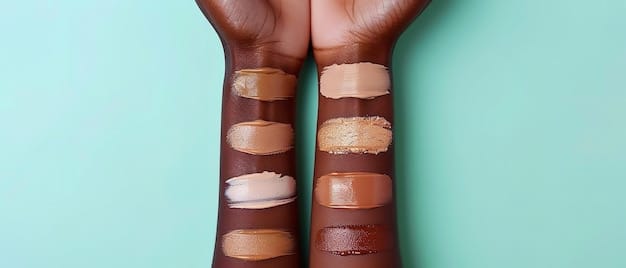The 2025 Guide: Choosing the Perfect Foundation for Your Skin

The 2025 Guide to Choosing the Right Foundation for Your Skin Type and Tone involves understanding your skin’s specific needs, identifying your undertones, and selecting a formula that offers the desired coverage and finish, ensuring a flawless and natural-looking complexion.
Finding the right foundation can feel like searching for a needle in a haystack, but The 2025 Guide to Choosing the Right Foundation for Your Skin Type and Tone simplifies the process, ensuring you achieve a flawless complexion every time.
Understanding Your Skin Type for Foundation Selection
Selecting the right foundation begins with understanding your skin type. Different skin types have different needs; therefore, knowing whether you have oily, dry, combination, or sensitive skin is crucial in making the right choice.
Each type reacts differently to various foundation formulas, so let’s examine how to navigate these differences.
Oily Skin Solutions
For oily skin, look for oil-free, non-comedogenic, and matte formulas. These foundations help control shine and prevent clogged pores, which can lead to breakouts.
Dry Skin Hydration
If you have dry skin, opt for hydrating or moisturizing foundations with ingredients like hyaluronic acid or glycerin. These formulas provide moisture and prevent the foundation from clinging to dry patches.

- Read labels carefully: Look for keywords like “oil-free,” “hydrating,” or “matte.”
- Consider powder foundations: These can help absorb excess oil for oily skin types.
- Avoid alcohol-based foundations: These can further dry out dry skin.
Understanding your skin type is the first step in the right direction. Matching your foundation to your skin type ensures a comfortable wear and a natural-looking finish.
Decoding Your Skin’s Undertones
Beyond skin type, understanding your skin’s undertones is essential for a seamless foundation match. Undertones are the subtle hues beneath your skin’s surface that influence how a foundation appears.
Identifying whether you have warm, cool, or neutral undertones will guide you in selecting the right shade.
Warm Undertones
Warm undertones have hints of yellow, peach, or gold. Foundation shades with a yellow or golden base complement warm undertones beautifully.
Cool Undertones
Cool undertones have hints of pink, red, or blue. Foundation shades with a pink or red base are ideal for cool undertones.
Neutral Undertones
Neutral undertones have a balance of warm and cool hues. Individuals with neutral undertones can often wear a wider range of foundation shades.
- The vein test: Look at the veins on your wrist. Blue or purple veins suggest cool undertones, while green veins indicate warm undertones. If you can’t tell, you likely have neutral undertones.
- Jewelry test: Gold jewelry tends to look better on warm undertones, while silver complements cool undertones.
- Consider your skin’s reaction to the sun: If you tan easily, you likely have warm undertones. If you burn easily, you probably have cool undertones.
Understanding your skin’s undertones can drastically improve your foundation match, resulting in a more natural and harmonious look.
Choosing the Right Foundation Formula
The market offers numerous foundation formulas, each with unique characteristics and benefits. Selecting the right formula depends on your skin type, desired coverage, and preferred finish.
From liquids and creams to powders and sticks, let’s explore the options.
Liquid Foundations
Liquid foundations are versatile and suitable for most skin types. They offer a range of coverage levels, from sheer to full, and various finishes, including matte, dewy, and satin.
Cream Foundations
Cream foundations are typically thicker and more hydrating than liquid foundations, making them ideal for dry or mature skin. They provide medium to full coverage and a dewy or radiant finish.
Powder Foundations
Powder foundations are excellent for oily or combination skin. They help absorb excess oil, provide light to medium coverage, and offer a matte finish.
Stick foundations offer convenience and portability. They provide medium to full coverage and can be easily applied and blended, making them great for touch-ups on the go.

- Consider your lifestyle: If you’re always on the go, a stick foundation might be the best choice.
- Think about the season: Lighter formulas are often preferred in the summer, while heavier formulas are suitable for winter.
- Read reviews: See what other users with similar skin types have to say about different formulas.
Choosing the right foundation formula can significantly enhance your overall makeup look and provide a comfortable wear.
Understanding Coverage Levels and Finishes
The levels of coverage and finishes a foundation offers can influence the final makeup look significantly. Understanding these can help you achieve your desired result.
Different occasions might require different levels of coverage, so let’s elaborate.
Coverage Levels
Sheer coverage provides a natural, barely-there look. It evens out skin tone without completely covering imperfections. It is best suited for people with overall good skin looking to give a natural boost.
Medium Coverage
Medium coverage evens out skin tone and covers minor imperfections like blemishes or redness. It offers a more polished look while still looking natural. It is best suited for daily wear when intending to have a more polished-looking presence.
Full Coverage
Full coverage conceals most imperfections, including acne, scars, and hyperpigmentation. It provides a flawless, photo-ready finish, that is suitable for times when you want to appear perfect, or in photographs. It is best suited for evenings out, weddings, or photoshoots.
A matte finish is shine-free and long-lasting, making it ideal for oily skin. It provides a smooth, poreless appearance. Best suited for times when long wear is necessary.
Dewy Finish
A dewy finish provides a radiant, luminous glow. It’s perfect for dry or mature skin, adding hydration and a youthful appearance. Best suited for evening wear where the soft lighting shows off the glow.
Satin Finish
A satin finish offers a balance between matte and dewy. It provides a natural-looking radiance without excess shine. The is the most natural look that is well suited for a ‘no-makeup look’, or to give the effect of perfect looking sin, naturally.
- Consider your skin’s needs: If you have acne, full coverage might be preferable.
- Think about the occasion: For everyday wear, sheer or medium coverage is often sufficient.
- Experiment with different finishes: See which finish complements your skin type and personal style.
Selecting the appropriate coverage level and finish, can drastically enhance your overall makeup look, and help you adapt your style to various occasions.
Application Techniques and Tools
How you apply your foundation can be as important as the foundation itself. Using the right tools and techniques can make a significant difference in achieving a flawless finish.
Whether you prefer brushes, sponges, or fingers, let’s examine how to utilize them effectively.
Foundation Brushes
Foundation brushes come in various shapes and sizes, each designed for specific purposes. Flat brushes are great for applying foundation in thin, even layers, while buffing brushes help blend the product seamlessly into the skin.
Makeup Sponges
Makeup sponges, like the Beautyblender, provide a natural, airbrushed finish. Dampen the sponge before use to prevent it from absorbing too much product. Use a bouncing motion to press the foundation into the skin.
Fingertip Application
Applying foundation with your fingertips can provide a natural, skin-like finish. The warmth of your fingers helps to melt the product into the skin. Use gentle, pressing motions to blend the foundation.
- Clean your tools regularly: Dirty brushes and sponges can harbor bacteria and lead to breakouts.
- Use the right amount of product: Start with a small amount and build coverage as needed.
- Blend thoroughly: Pay extra attention to the hairline, jawline, and around the nose.
Mastering the art of foundation application ensures that the product is applied evenly, seamlessly, and naturally.
Testing and Shade Matching
The final step in choosing the right foundation is testing the product and ensuring a perfect shade match. Proper testing will prevent the purchase of a foundation that is incompatible with your skin.
Testing the product in natural light is crucial for an accurate match.
Testing in Natural Light
Always test foundation in natural light. Indoor lighting can distort the shade and make it appear different than it actually is. Apply a small amount of product to your jawline and check the color in natural daylight.
Matching to Your Chest
If you’re unsure about your undertones, match the foundation to the color of your chest. This can help ensure a seamless blend between your face and body. Apply a small amount of product to your jawline and blend downwards to see if it matches your chest.
Considering Seasonal Changes
Your skin tone can change throughout the year due to sun exposure. Adjust your foundation shade accordingly. You might need a lighter shade in the winter and a darker shade in the summer.
- Get samples: Many makeup counters offer samples of foundation. Take advantage of this to test different shades and formulas at home.
- Take your time: Don’t rush the shade-matching process. It’s better to take your time and find the perfect match.
- Consult with a professional: If you’re still unsure, seek advice from a makeup artist or beauty consultant.
Testing and shade matching ensures, that your foundation blends seamlessly into your skin and gives an enhanced natural look.
| Key Point | Brief Description |
|---|---|
| ✨ Skin Type | Match foundation to oily, dry, combination, or sensitive skin. |
| 🎨 Undertones | Identify warm, cool, or neutral undertones for shade selection. |
| 🧴 Formula | Choose liquid, cream, powder, or stick based on skin and needs. |
| 🧪 Testing | Test in natural light, match to chest, adjust seasonally. |
FAQ Section
▼
Observe your skin throughout the day. If it’s shiny, you likely have oily skin. If it feels tight or flaky, you have dry skin. Combination skin features both oily and dry areas.
▼
Non-comedogenic means the product is formulated not to clog pores. This is especially important for those with oily or acne-prone skin to prevent breakouts.
▼
Typically, liquid foundations should be replaced every 6-12 months, while powder foundations can last up to two years. Always check for changes in texture or smell.
▼
Yes, mixing foundations can help you achieve a customized shade or finish. However, ensure the foundations have compatible formulas to avoid separation or clumping.
▼
For mature skin, use a hydrating foundation applied with a damp sponge. Avoid heavy formulas that can settle into fine lines and wrinkles. Focus on lightweight coverage.
Conclusion
Choosing the right foundation involves understanding your skin type, identifying your undertones, selecting the appropriate formula, mastering application techniques, and ensuring a perfect shade match. With these guidelines, you’ll be well-equipped to achieve a flawless complexion with your cosmetics.





